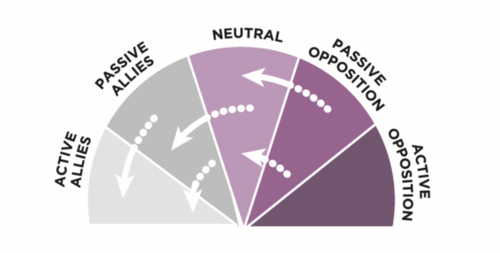Spectrum of allies: Difference between revisions
No edit summary |
No edit summary |
||
| Line 5: | Line 5: | ||
<br>[[File:Screen Shot 2022-10-20 at 4.06.27 PM.png|500px|center|border|Source: George Lakey, Training for Change]] | <br>[[File:Screen Shot 2022-10-20 at 4.06.27 PM.png|500px|center|border|Source: George Lakey, Training for Change]] Source: George Lakey, Training for Change</p> | ||
Revision as of 20:10, 20 October 2022
Spectrum of allies describes a concept that examines the potential opposition and support of people and groups, ranging from those who are most dedicated opponents to the most active supporters; helpful tool for deciding what tactics to employ based on a team’s relation to specific allies. - 350.org, adapted by Michelle Xie [1]
This tool is helpful in identifying the social groups (students, workers) that are affected by your issue, and to locate those groups along a spectrum, so you can focus your efforts on shifting those groups closer to your position. The tool also encourages looking at society as a collection of specific communities, some of which can be defined as institutions (unions, churches, schools), others of which are less visible such as youth subcultures or demographic groups. Identify impacted communities can help you develop a more targeted strategy that moves groups closer to your position.

Source: George Lakey, Training for Change
How to use the spectrum of allies
If you have any suggested revisions or additional resources to share related to the above content, please email them to kenzie@lehub.ca.
